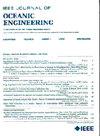Trajectory Tracking Control for a Hybrid Underwater Vehicle in Free-Flying and Crawling Operation Modes
IF 5.3
2区 工程技术
Q1 ENGINEERING, CIVIL
引用次数: 0
Abstract
A hybrid underwater vehicle (HUV) equipped with thrusters and tracks has the great ability of free flying in the water and crawling on the surfaces of underwater structures, making it highly effective for inspecting underwater structures and cleaning hulls. In this article, a novel cascade control strategy that consists of a kinematic controller and a dynamic controller is proposed for trajectory tracking control of HUVs in free-flying and crawling operation modes. Based on the tracking error, a model predictive control (MPC)-based kinematic controller is designed for both free-flying and crawling modes. To improve the tracking accuracy, an improved snake optimizer is used in the optimization process of MPC to derive the expected optimal velocity. Then, the error between the expected optimal velocity and the real velocity is used as the input of the dynamic controller. To compensate for external disturbances, such as ocean currents and waves, a dynamic controller composed of a nonlinear disturbance observer and an integral sliding mode control (ISMC) is adopted to optimize the thrust force for trajectory tracking in free-flying mode. In addition, a dynamic controller composed of a radial basis function neural network and an ISMC is established to reduce the impact of slipperiness in crawling mode. The simulation results show that the proposed cascade trajectory tracking control strategy for HUVs in free-flying and crawling modes can improve the trajectory tracking accuracy and robustness to unknown dynamic factors.自由飞行和爬行混合动力水下航行器的轨迹跟踪控制
混合动力水下航行器(HUV)配备了推进器和履带,具有强大的水中自由飞行能力和在水下结构物表面爬行的能力,对水下结构物的检查和船体的清洗非常有效。本文提出了一种由运动控制器和动态控制器组成的串级控制策略,用于huv在自由飞行和爬行工况下的轨迹跟踪控制。基于跟踪误差,设计了一种基于模型预测控制(MPC)的自由飞行模式和爬行模式运动控制器。为了提高MPC的跟踪精度,在MPC的优化过程中使用了改进的蛇形优化器来推导期望最优速度。然后,将期望最优速度与实际速度之间的误差作为动态控制器的输入。为了补偿海流和海浪等外部扰动,采用非线性扰动观测器和积分滑模控制(ISMC)组成的动态控制器对自由飞行模式下的轨迹跟踪推力进行优化。此外,建立了由径向基函数神经网络和ISMC组成的动态控制器,以减少爬行模式下滑溜的影响。仿真结果表明,所提出的huv自由飞行和爬行两种模式的串级轨迹跟踪控制策略能够提高huv的轨迹跟踪精度和对未知动态因素的鲁棒性。
本文章由计算机程序翻译,如有差异,请以英文原文为准。
求助全文
约1分钟内获得全文
求助全文
来源期刊

IEEE Journal of Oceanic Engineering
工程技术-工程:大洋
CiteScore
9.60
自引率
12.20%
发文量
86
审稿时长
12 months
期刊介绍:
The IEEE Journal of Oceanic Engineering (ISSN 0364-9059) is the online-only quarterly publication of the IEEE Oceanic Engineering Society (IEEE OES). The scope of the Journal is the field of interest of the IEEE OES, which encompasses all aspects of science, engineering, and technology that address research, development, and operations pertaining to all bodies of water. This includes the creation of new capabilities and technologies from concept design through prototypes, testing, and operational systems to sense, explore, understand, develop, use, and responsibly manage natural resources.
 求助内容:
求助内容: 应助结果提醒方式:
应助结果提醒方式:


